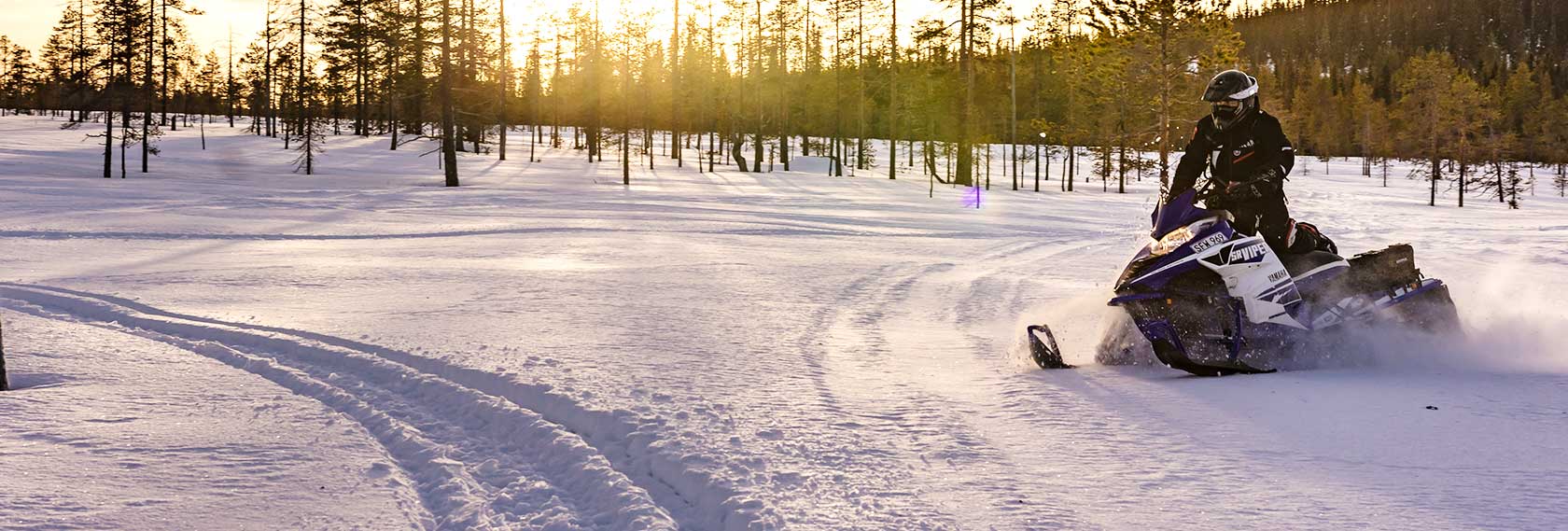

I’m sure you are all aware of the hazards associated with riding off-trail in snow-covered fields, such as rocks, tree stumps and other obstructions hidden under the snow. You also know enough (I hope) to keep to the right while snowmobiling on a trail and not to stop in the trail, near curves, near tops of hills or near bottoms of hills. Now, let’s revisit some lesser talked about “On the Trail” hazards.
Groomers: Have you ever seen the signs along the trail stating “Grooming at all Hours of the Day and Night” or something to that effect? Groomer accidents can be fatal.
Today’s large groomers often take up the entire width of a snowmobile trail. Communicating the presence of a groomer on the trail is not an easy task. It is currently accomplished by means of high visibility paint, fixed lights, flashing lights, and warning beacon radio signals transmitted directly to a snowmobiler’s helmet communicator. The safety warning to “Always Expect a Groomer – Day or Night” is vital to your safety. Just imagine zipping along the trail, shifting your body in anticipation of entering a sharp curve and meeting up with a heavy groomer plow blade taking up the entire trail width. What would you do? Would you be able to stop in time?
As a groomer operator, I have personally experienced meeting an out of control sled barreling around a corner. I immediately hit the brake and came to a sudden halt from my grooming speed of six-miles per hour. Then I just watched helplessly as the approaching rider tried to (then realized he couldn’t) steer around my 40-foot rig. He struggled mightily to control his sled before making a last ditch decision to leave the trail and thereby avoid certain death by hitting the groomer head on. He simply ran off the trail into the woods where he miraculously missed hitting a big tree. He was lucky. He only hit small trees and lived to ride another day (hopefully more carefully).
Frozen water: It is early in the season and you are happily riding down the trail. You round a curve and are suddenly faced with a possible life-threatening dilemma – a frozen body of water. You stop your sled and scan ahead on the ice. You see nothing but freshly fallen, undisturbed snow ahead of you. There are no other tracks. Thoughts like “Will I make it across?” creep into your mind. You’re flying high since it is your first ride of the season and you feel invincible. You say to yourself, “Go for it.” and you jam the throttle to the handlebar. Your sled leaps forward and you are soon “flying” across the ice. You have done this before and survived and you fully expect to make it across today. You probably will; but each year a number of your fellow snowmobilers won’t!
Trees: Trees have been known to occasionally fall down across trails between grooming runs. Imagine that! I know a couple of folks who have plowed into obstructions like this in the middle of a well-ridden trail that they had been over earlier in the day. They were not “Riding in Control” and paid dearly for that decision.
Unexpected road crossings: Another potentially dangerous scenario most snowmobilers have experienced and lived through involves unexpected road crossings. You’re flying through a snow-covered field with many changes in elevation, which limit your visibility. You approach a gradual rise and you stay to the right and keep on going. Suddenly at the top of a rise, you see a rural road crossing the trail, along with a snowmobile trail stop sign, but you are going too fast to stop. You hit the brakes anyway and glance to the right and then to the left. No traffic is in sight as you cross the road without being able to stop. You silently take a vow to be more careful next time.
I was behind a fellow rider once who was flying along trying to get back to the motel before one of his friends. As he raced up a steep hill without slowing near the top, I began to wonder if he remembered that there was a four-lane highway right at the crest of the hill. He became airborne as he crested the hill. It seemed kind of funny at the time seeing his brake light come on while he was up off the ground and flying through the air. He returned to earth in the travelled lane of the highway. I stopped at the top and observed him slip through a small gap between a couple of tractor trailers coming one way and a couple of cars coming the other way. Needless to say he was pretty shook up.
Sharp turns: There are many trails that have 90 degree or greater turns that are not at an intersection and not marked. Imagine cruising along when you encounter such a turn. As you start to realize that the turn is sharper than you expected, you begin an uncontrollable drift into the center where you are not supposed to be. You figure, that any second now the turn will straighten out and you will be ok. It doesn’t straighten out and it keeps turning. Now what? After what seems like an eternity, you make it through the turn on the wrong side of the trail, happy that no one was coming the other way to hit you head on. “Wow” you say as you speed back up, “I was lucky. I’ll have to remember that spot for my next trip!”
Please keep these dangerous “On-Trail” hazardous situations in mind, educate your family and friends and above all don’t become a snowmobiling casualty.
Randy Toth is a certified Vermont State Police Safety Education Program Snowmobile Instructor
Photos by Jeff Gamelli, Becky Jurek, Terry Holland